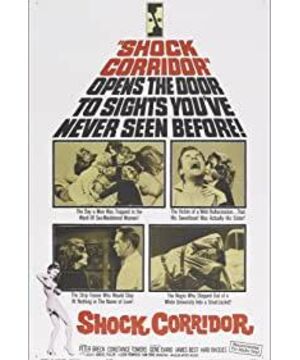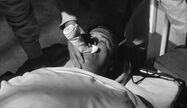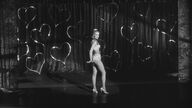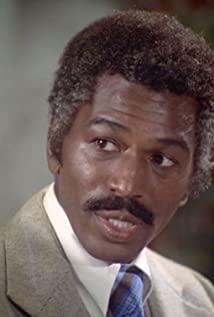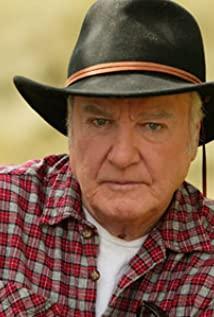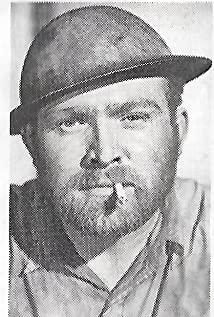Compared with Fuller's other works, "Corridor of Horror" should be regarded as an atypical noir film. At the beginning of the film, the famous line of the Greek tragedy master Euripides in 425 BC - "God destroys man must first make him mad." Then there is the protagonist of the story, Johnny, who uses the strip girl Kathy to pretend to be a victim of himself. The sexually assaulted sister passed the psychiatric evaluation by pretending to be insane. This move will allow him to explore the truth about a murder in the hospital, to gain access to witnesses, and to write it as a literary report in order to compete for the Pulitzer Prize. At the beginning of the plan, Casey begged Johnny to give up the crazy idea, but in the face of Johnny's greed and the conspiracy of the newspaper boss, Casey reluctantly agreed. However, throughout the whole film, the mission of investigating the truth has long been left behind by Johnny, and all that remains are the endless horror corridors and the protagonists who are on the verge of collapse.
On the surface, Fuller did not intend to tell a well-thought-out detective story, but tried his best to add his dissatisfaction with American society to this gloomy story. In the film, the three patients visited by the reporter unannounced can be regarded as representatives of social persecution in that era. Among them, there are veterans who participated in World War II and the Korean War. They were captured by the communists during the war. Even after the war was over, the tortuous experience still could not erase the stains of life. Under pressure, he turned himself into a Confederate general during the Civil War, and achieved victory in an imaginary battle; some black students who were studying on college campuses after the United States announced the abolition of the educational segregation policy, still suffered from discrimination by white teachers and students. Under the pressure of the environment, he turned himself into a member of the Ku Klux Klan, shouted racist slogans, and even put on a uniform to encourage his patients to attack other black people in his obscenity; When you find that your wisdom has become an accomplice of countless war victims, the best way to go crazy is to return yourself to the age of six, and save your conscience through deprivation of wisdom.
Behind the crazy behavior of the three patients, there are hidden their sorrowful accusations of that era. While Johnny was exploring the truth of the case, he also lost his mind because he could not bear the huge pressure brought by dual identities. In this closed space, on one side is a mental hospital packed with hypocrisy and hypocritical morality, and on the other side is a country driven to madness by selfish desires and desire for power. Fuller used an extremely aggressive attitude to challenge American society, and also implied that people in the dark have only two choices: either compromise or go crazy. In order to make Johnny go mad faster, Fuller even added the most important prop in the film - a portrait of Johnny painted by a scientist, which is subtly consistent with the French psychoanalyst Lacan's "mirror" theory. Johnny suddenly collapsed when he saw the portrait, but the film did not explain what was drawn in the portrait. In fact, according to Lacan's theory, what Johnny saw should be a mirror. Before looking in the mirror, he still believed that he was a normal person and was still trying to compromise with society, but the trauma of the "mirror" directly tore the fig leaf of his soul. , when faced with reality, there is no other way but to go crazy.
From today's point of view, the film was shot in 1963, when the United States was just beginning to sink into the Vietnam War. Fuller's "Corridor of Horrors" comes out a month after Luther King's black movement made its "great march" to Washington! There were many movies about mental illness in that era. Long's "Metropolis" is an original idea, but its predictability and reality are the greatest - Fuller, through the mouth of a madman, released the Cold War mentality, belligerent tendencies, racism and totalitarian violence heartily and vividly to the United States. The ridicule of this huge insane asylum is almost to the point of naming names, so that we begin to have reason to believe that under the weight of the country's sins, everyone has a possibility of finesse.
Although Fuller spared no effort to express his anger from the beginning to the end of the film, it still opened a bright road for people. In the black and white hard light images, three color images (rough documentary texture) appeared, all presented in the patient's fantasy. The majestic Buddha, the beautiful Mount Fuji, the Japanese in kimonos, the wild African continent, and the black people holding ceremonies. Fuller's longing for the mysterious East and his respect for the primitive society of nature are obvious, and it seems to imply that only the scouring of natural forces is the best medicine for mankind to avoid madness. And this succinct montage insertion subtly satirizes the gap between reality and ideal. In addition, the camera movements that emphasize emotional reactions are very restrained, and the composition in the hospital tends to be balanced in the middle ground. The most classic scene is Johnny's hallucination in the "horror corridor". Use three left-to-right panning shots to express the surreal phenomena in the ordinary field of view. It can be seen that this film is a fairly solid B-level film. Fuller serves as the director, screenwriter, producer and other positions of the film. At a low cost, the actors are dispatched to shape the spiritual level through the illusion of the film. In the real world, it is not easy to create the superposition effect of "rainstorm corridor" in repeated scenes!
As a B-level film, this film has another distinctive feature, which is "absurd". A little thought reveals that Johnny's plan is very flawed, the mentally ill can't testify in court at all, and all his testimony has no legal effect. At this point, we can speculate on the original intention of the director to shoot this film, he is just making an absurd and crazy story. You can be captivated by its funny and tense storyline or its rough and edgy style. And that's what's so lovely about American cinema: Throughout history, there's always been a place for high-quality human care, and low cost has never been an excuse for a bad movie.
Published in "Watching Movies"
View more about Shock Corridor reviews


